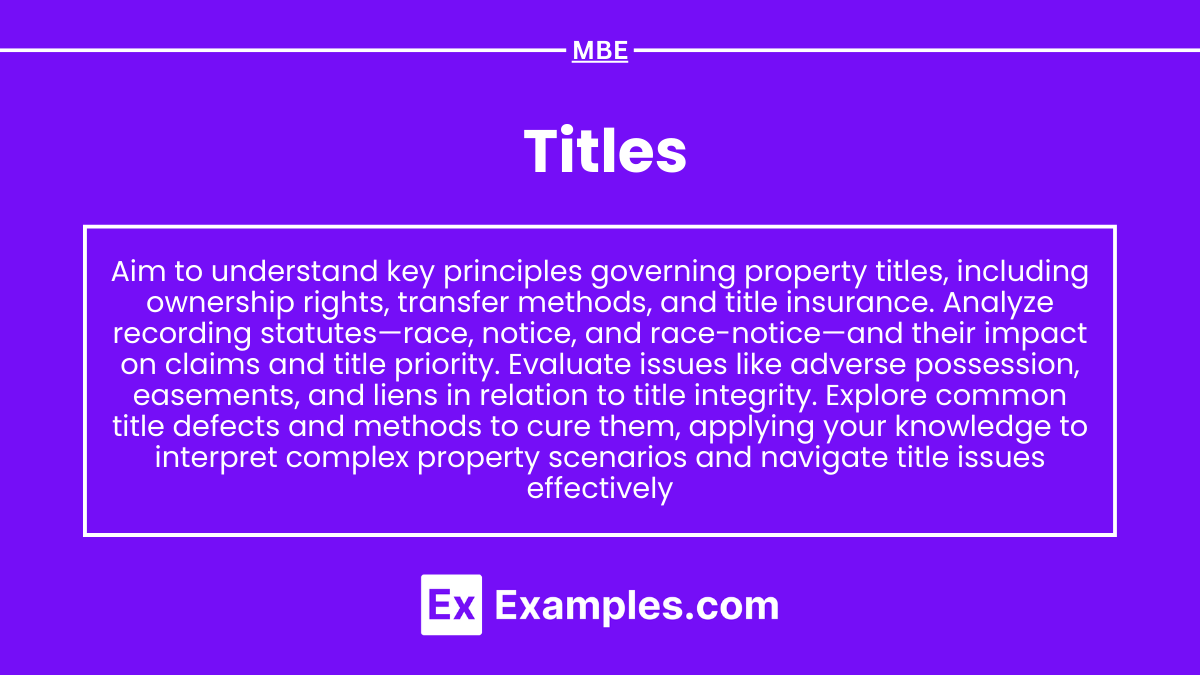Preparing for the MBE Exam requires a thorough understanding of property titles, a key component in real property law. Mastery of title acquisition, types of ownership, recording statutes, and title defects is essential. This knowledge provides insight into property rights, transfers, and disputes, critical for achieving a high MBE score.
Learning Objective
In studying “Titles” for the MBE Exam, you should aim to understand the key principles governing property titles, including ownership rights, transfer methods, and the role of title insurance. Analyze how various recording statutes, such as race, notice, and race-notice statutes, impact property claims and title priority. Evaluate the legal issues surrounding adverse possession, easements, and liens as they relate to title integrity. Additionally, explore common title defects and the requirements for curing them. Apply your understanding of title-related laws to interpret complex property scenarios in MBE practice questions, preparing to navigate title issues effectively on the exam.
Understanding Property Titles
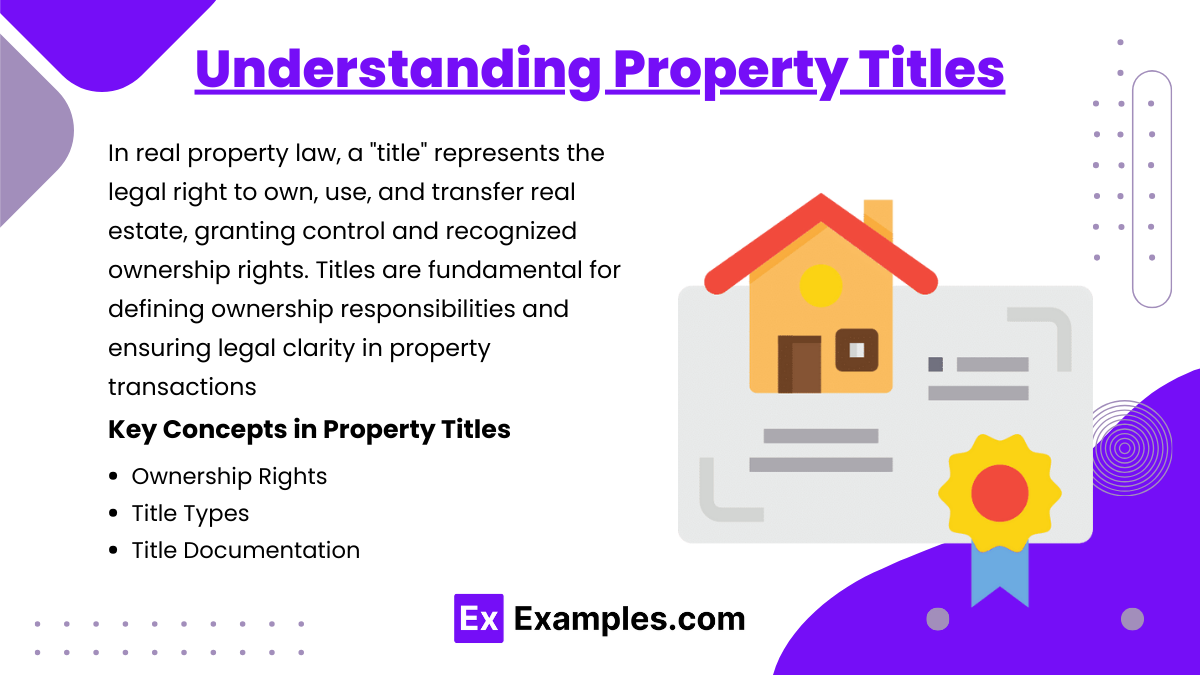
In real property law, a “title” represents the legal right to own, use, and transfer real estate. Holding title to property means you have recognized ownership rights, giving you the ability to control the property, decide who can use it, and potentially exclude others from accessing it. Titles play a fundamental role in defining ownership rights and responsibilities, which makes them crucial for legal clarity in property transactions.
Key Concepts in Property Titles
- Ownership Rights: When you hold the title to a property, you have the right to possess, control, and transfer it. Ownership rights also include the “bundle of rights”—the rights to use, lease, encumber, and even sell or transfer the property to others. These rights are foundational to property law and determine what an owner can and cannot do with their property.
- Title Types: Ownership in property law is complex, as there are various ways title can be held:
- Fee Simple: The most comprehensive ownership, granting full rights to use, transfer, or inherit the property without limitation.
- Joint Tenancy: Ownership shared with one or more parties, including the “right of survivorship,” meaning the property automatically transfers to surviving co-owners upon death.
- Tenancy in Common: Multiple individuals can hold separate shares, which can be independently sold or inherited without affecting other owners.
- Life Estate: Ownership that lasts for the holder’s lifetime, after which the property reverts to another designated party.
- Title Documentation: Ownership is proven through documentation, typically a deed, which outlines the legal transfer of property. Different types of deeds—such as warranty deeds and quitclaim deeds—provide varying levels of assurance regarding title validity and protection against claims.
Title Transfer and Acquisition
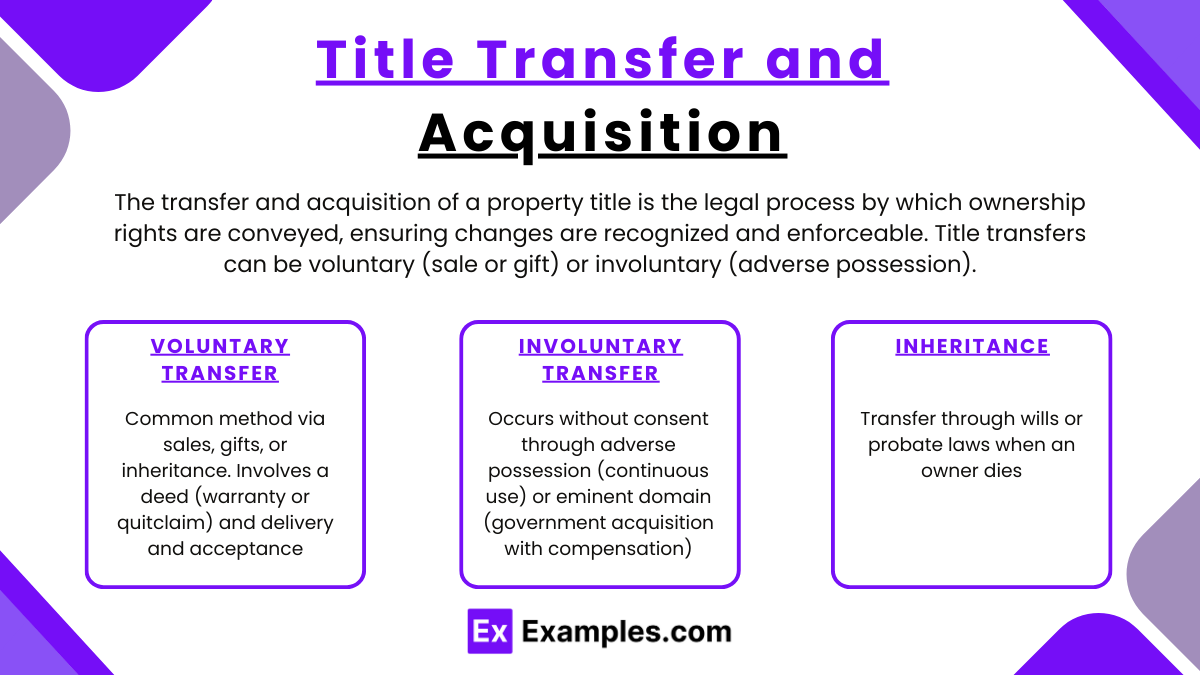
The transfer and acquisition of a property title involve the legal process through which ownership rights are conveyed from one party to another. This process is critical in real estate, ensuring that ownership changes are legally recognized, clear, and enforceable. Title transfer can occur voluntarily, through sale or gift, or involuntarily, such as through adverse possession.
Key Methods of Title Transfer
- Voluntary Transfer: This is the most common way to transfer title and includes transactions like sales, gifts, or inheritance. For a transfer to be valid, certain steps are typically required:
- Execution of a Deed: The deed is the legal document that formally transfers ownership. There are various types of deeds, including warranty deeds, which offer assurances about the title’s validity, and quitclaim deeds, which transfer whatever interest the grantor has without guarantees.
- Delivery and Acceptance: For a title transfer to be complete, the deed must be delivered to the recipient (grantee) and accepted by them. This step legally finalizes the transfer, ensuring the new owner has taken possession of the title.
- Involuntary Transfer: Ownership can also transfer without the original owner’s consent under certain conditions, such as:
- Adverse Possession: This process allows a person who occupies a property continuously, openly, exclusively, and without permission for a statutory period to claim legal ownership. Each state has specific requirements for the time and conditions under which adverse possession is granted.
- Eminent Domain: The government can take private property for public use with compensation, which is another form of involuntary transfer.
- Inheritance: Property can also be transferred through wills and intestate succession (when a person dies without a will). Laws of inheritance and probate determine the distribution of property, ensuring legal transfer to heirs or designated beneficiaries.
Requirements for Valid Title Transfer
For a title transfer to be legally valid, the following are generally required:
- Competency: The grantor (person transferring the title) must be of sound mind and legal age.
- Consideration: In many cases, especially sales, consideration (value exchanged) is specified in the deed.
- Acknowledgment and Recording: Deeds are often notarized and recorded in public records, protecting the grantee’s rights by providing public notice of the transfer.
Recording Statutes and Title Priority
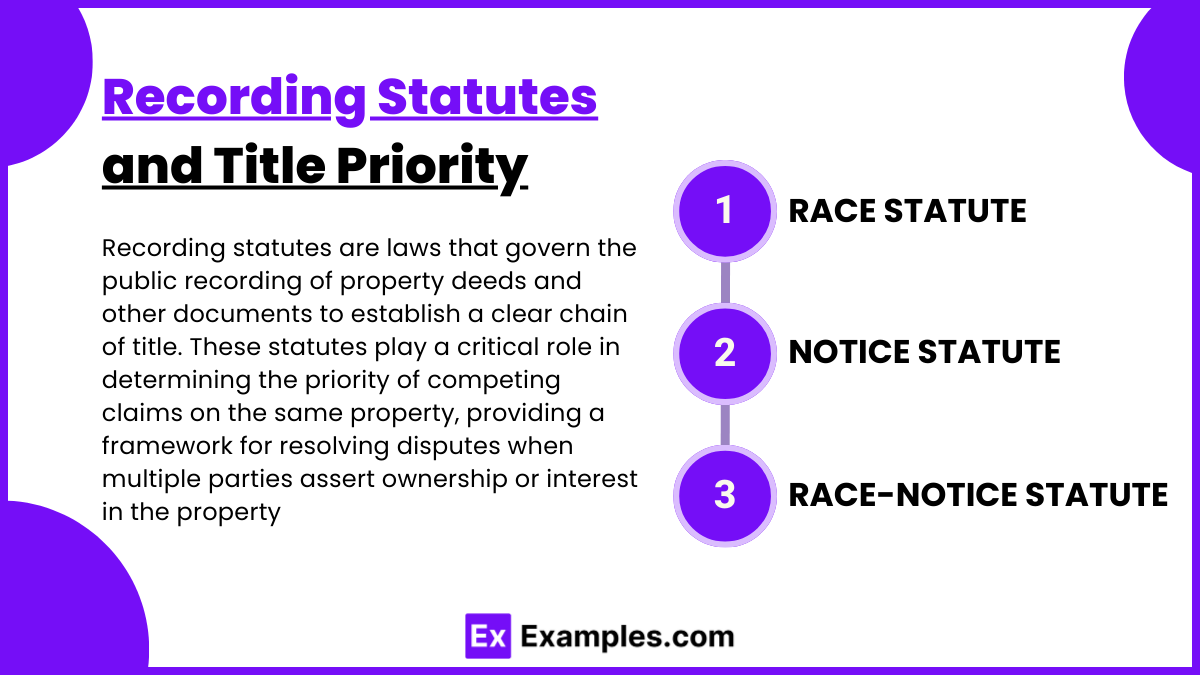
Recording statutes are laws that govern the public recording of property deeds and other documents to establish a clear chain of title. These statutes play a critical role in determining the priority of competing claims on the same property, providing a framework for resolving disputes when multiple parties assert ownership or interest in the property. Title priority is the legal ranking of these interests, and recording statutes help ensure transparency, protect property rights, and reduce conflicts.
Types of Recording Statutes
There are three main types of recording statutes in U.S. property law, each with unique rules for establishing title priority:
- Race Statute: In jurisdictions with a race statute, the first party to record their claim (such as a deed) has priority, regardless of any prior unrecorded claims. Under this statute, it doesn’t matter if the person recording the claim knew about another prior claim; the priority is simply given to whoever records first. This is the simplest form of title priority, but it is less common because it does not account for fairness if one party acted in bad faith.
- Notice Statute: In a notice jurisdiction, priority is given to the most recent party who acquired the title without knowledge of any previous unrecorded claims. This “bona fide purchaser” rule means that if someone buys a property without knowledge of an earlier, unrecorded claim, they will hold priority as long as they record the transaction. This statute prioritizes the fairness of giving rights to parties acting in good faith, even if they are not the first to record.
- Race-Notice Statute: The race-notice statute combines elements of both the race and notice statutes. In these jurisdictions, priority is given to the party who both (1) records their claim first and (2) purchases the property without knowledge of any prior unrecorded claims. This statute is common because it protects both diligent recording and good faith purchases, ensuring that priority goes to those who act responsibly and without knowledge of conflicting claims.
Importance of Recording and Title Priority
Recording statutes protect property owners and buyers by providing a public record of property transactions, which helps prevent fraud, establish title history, and give buyers confidence that they are purchasing clear title. Here’s why recording and priority matter:
- Clear Ownership History: Recording all property transactions helps establish a public record, clarifying who holds title at any point. This record protects current and future owners from disputes over ownership.
- Protection for Good-Faith Purchasers: Recording statutes, especially notice and race-notice statutes, protect good-faith purchasers who acquire property without knowledge of previous claims. This protection incentivizes buyers to conduct due diligence by checking public records before purchasing property.
- Dispute Resolution: In cases of competing claims, recording statutes provide a legal basis for determining who has superior rights. This reduces the risk of prolonged legal battles and ensures that ownership is awarded based on consistent rules.
Title Defects and Remedies
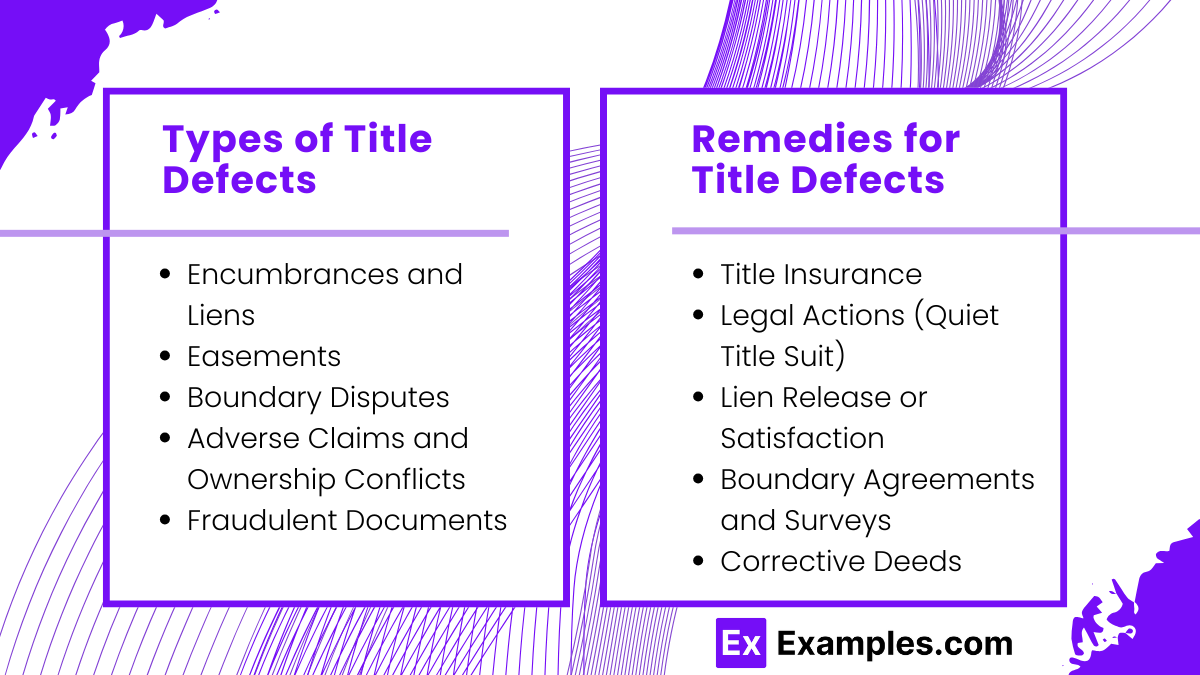
Title defects are issues or “clouds” on a property title that may compromise the ownership rights or marketability of the property. These defects can arise from various sources, such as unpaid liens, boundary disputes, or unresolved claims from prior owners. Title defects are significant because they can lead to legal challenges and financial losses for the property owner, buyer, or lender. Remedies for curing these defects help ensure clear, undisputed ownership and protect parties involved in real estate transactions.
Types of Title Defects
- Encumbrances and Liens: Liens are legal claims against a property due to unpaid debts, such as mortgages, property taxes, or mechanic’s liens (related to unpaid construction work). Encumbrances like liens restrict ownership rights and can result in foreclosure if not addressed. Liens must often be paid off or resolved before a property can be sold or transferred with a clear title.
- Easements: An easement grants others a legal right to use a portion of the property for a specific purpose, such as access to a utility line or a shared driveway. Although easements do not necessarily affect ownership, they can impact the marketability and value of the property. Easements should be documented and disclosed to avoid future disputes.
- Boundary Disputes: Discrepancies in property boundaries, often due to conflicting surveys or unmarked property lines, can lead to disputes with neighboring property owners. These issues may result in a cloud on the title, complicating future sales or property improvements.
- Adverse Claims and Ownership Conflicts: Sometimes, unresolved ownership claims from previous owners or third parties can create title defects. These claims may include unrecorded deeds, unknown heirs, or prior agreements that weren’t properly documented. Adverse claims can challenge the current owner’s legal rights to the property.
- Fraudulent Documents: Forged deeds or fraudulent transfers are severe title defects that compromise property ownership rights. These documents may have been used to transfer the title without proper authorization, and they can lead to significant legal complications.
Remedies for Title Defects
When title defects are discovered, various remedies can help clear the title and resolve disputes:
- Title Insurance: Title insurance protects the buyer and lender from financial loss due to unforeseen title defects that may arise after the purchase. A title insurance policy may cover expenses for resolving title issues, compensating the owner, or defending against adverse claims. There are two main types of coverage:
- Owner’s Title Insurance: Protects the property owner against losses from title defects.
- Lender’s Title Insurance: Protects the lender’s interest in the property, typically required as part of a mortgage.
- Legal Actions (Quiet Title Suit): A quiet title suit is a legal action filed to establish clear ownership and eliminate any adverse claims. This lawsuit is often necessary when there are unresolved disputes, such as conflicting ownership or adverse possession claims. A successful quiet title suit results in a court order declaring the rightful owner, effectively clearing the title.
- Lien Release or Satisfaction: Paying off or negotiating unpaid liens can remove this encumbrance from the title. For example, a property owner might pay outstanding property taxes or negotiate a mechanic’s lien settlement, after which the lien holder issues a release or satisfaction document to confirm that the lien has been resolved.
- Boundary Agreements and Surveys: When boundary disputes arise, a new survey or boundary agreement with neighboring owners can clarify property lines. Documenting these agreements and recording them publicly ensures future clarity on property boundaries, preventing future disputes.
- Corrective Deeds: In cases where a title defect results from a recording error, such as a misspelled name or incorrect property description, a corrective deed can be filed. This document amends the original deed and clarifies the title, removing minor defects.
Examples
Example 1
A buyer purchases a property and records the deed under a race-notice statute. Unknown to the buyer, a prior owner had sold the property to another party who never recorded their deed. Since the buyer recorded first and purchased without notice of the previous sale, they have priority under the race-notice rule.
Example 2
An individual claims ownership of a vacant lot through adverse possession, having occupied it openly, continuously, and exclusively for the statutory period required by the state. After meeting these requirements, the individual files a quiet title suit to clear any competing claims, resulting in a court order that formally establishes their ownership.
Example 3
A homeowner discovers that their property has an undisclosed lien from a prior owner’s unpaid property taxes. The lien was not revealed in the title search. The homeowner’s title insurance covers the outstanding lien, paying it off to protect the homeowner’s interest in the property.
Example 4
A buyer purchases a property with a warranty deed, ensuring that the seller has clear title and is guaranteeing against any future claims on the title. Later, a distant relative of a previous owner claims an interest in the property. The buyer files a claim with their title insurance company, which handles the legal defense and reimburses any related costs.
Example 5
A developer buys a piece of land without realizing that a neighboring property owner holds an easement allowing them to use a portion of it as a driveway. The easement was unrecorded but later discovered. The developer negotiates with the neighbor to buy out the easement or relocate it to avoid impacting their construction plans.
Practice Questions
Question 1
Under a race-notice statute, which party has priority in a property dispute involving two buyers of the same property?
A. The first buyer to record, regardless of knowledge of other claims
B. The first buyer to record who had no knowledge of prior claims
C. The buyer who purchased the property first
D. The buyer with a warranty deed
Answer: B
Explanation: In a race-notice jurisdiction, priority is given to the first buyer who both records the transaction and had no knowledge of prior unrecorded claims at the time of purchase. This statute combines the principles of race and notice, ensuring that only a diligent buyer who is unaware of competing claims gains priority.
Question 2
Which type of deed provides the highest level of protection to the buyer by guaranteeing that the seller has a clear title and the legal right to transfer it?
A. Quitclaim deed
B. Special warranty deed
C. Bargain and sale deed
D. General warranty deed
Answer: D
Explanation: A general warranty deed provides the highest level of protection to the buyer. It guarantees that the seller holds a clear title and covers any claims or defects in the title, even those arising before the seller owned the property. Other types of deeds offer more limited protection or no guarantees at all.
Question 3
In a property dispute, which of the following is the purpose of a quiet title suit?
A. To remove liens from a property
B. To allow a lender to foreclose on a property
C. To establish clear ownership and settle disputes over title
D. To prevent future claims against a property
Answer: C
Explanation: A quiet title suit is a legal action taken to establish clear ownership and resolve disputes over title. It “quiets” any adverse claims, allowing the court to formally declare the rightful owner of the property. This remedy is particularly useful when multiple parties assert ownership or there are competing claims on the property.

